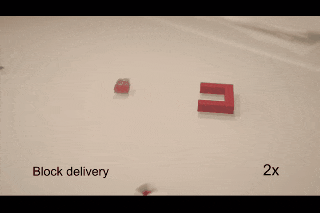All Gods Must Die Seattle Origami
It may sound like a machine from a sci-fi film, but a tiny self-folding 'origami' robot that can walk and swim, before self-destructing, has been revealed.
Small enough to sit on a fingertip and weighing less than a third of gram, the device is controlled by a magnetic field and can even carry heavy loads, relative to its own size and weight.
If it becomes small enough, such a robot could one day been used in surgery to perform medical tasks from the inside of the body, before dissolving.
Scroll down for video

A tiny self-folding 'origami robot that can walk (pictured navigating obstacles) and swim, before self-destructing, has been revealed
It is the first time a robot has been able to go through a whole 'life cycle,' the Institute of Electrical and Electronic Engineers (IEEE's)Spectrum magazine reported.
The device, which measures just two thirds of an inch (1.7cm) in length, was developed by a team from MIT's Computer Science and Artificial Intelligence Laboratory and the Technische Universität München.
The researchers have been working on origami-inspired machines since 2012.
Their latest tiny robot is made from a sheets of PVC and laser-cut layers of polystyrene and paper with a magnet inside it.
Once heated, it folds into an origami shape in less than a minute.
It is the first time a robot has been able to go through a whole 'life cycle'. Here, the bot that's controlled by an electric field, can be seen walking along a person's palm
Small enough to sit on a fingertip and weighing less than a third of gram, the device is controlled by a magnetic field and can even carry heavy loads, relative to its own size and weight. The top part of this image shows how the sheet of PVC is folded, while its walking and swimming action is illustrated beneath
In a video, the robot can be seen zipping around at speeds of one-and-a-half inches (between three and four centimetres) per second, swimming, climbing slopes and pushing double its weight, by vibrating.
This is due to an external magnetic field, which is projected from four coils in a box beneath it, without the need for a battery in the robot itself.
The magnetic field doesn't simply drag the device along but causes the magnet inside it to oscillate backwards and forwards.
The robot is able to move thanks to an external magnetic field, which is projected from four coils in a box beneath it (pictured), without the need for a battery in the robot itself. Currently, the machine can be instructed to self-destruct by entering a tank full of acetone (also illustrated), which dissolves everything but the magnet

The magnetic field doesn't simply drag the device along but causes the magnet inside it to oscillate backwards and forwards so its legs make contact with the ground, allowing it to walk and push objects (shown)
This means its front and back 'legs' make contact with the ground, which when combined with the bot being slightly heavier at the front, make it walk along.
The origami shape also means it's more efficient at moving objects and digging than using a simple magnet.
The robot can be instructed to self-destruct, by being driven into a tank of acetone where it dissolves, only leaving a tiny magnet behind.
Experts believe it will be possible to make all traces of the robot disappear in future, as well as making it operate independently from inside the body.
The tiny robot was shown off at the IEEE's International Conference on Robotics and Automation in Seattle.
'ORIGAMI' DRONE CAN INSTANTLY UNFOLD TO TAKE OFF
French researchers at EPFL and NCCR Robotics recently unveiled an 'origami' drone that can fold up its arms to save space - making it small enough to fit in a jacket pocket.
To launch it, the owner can simply hold it out, because the quadcopter then comes to life, unfurling its arms before taking off in a third of a second.
'The novelty of the robot is that it can fold or unfold its rotors in under half a second,' said Dario Floreano, who led the research.
To launch the origami drone (pictured folded up on the left), the owner can simply hold it out, because the quadcopter then comes to life, unfurling its arms (right) before taking off in a third of a second
'You can carry many of these in a backpack, for instance, and just let them loose when you need them.'
For example, the device could be quickly released in large numbers over a disaster zone in order to bring back photos and establish contact with people in need.
The arms, made of fibreglass and light inelastic polyester, fold up into the shape of a trapezoid.
When not in use, they wrap horizontally around the body of the device.
'What sets this device apart is the ability of the arms to unfold by themselves: the force generated by the rotors causes the arms to move into place,' the researchers say.
The rotors turn in the same direction, causing the arms to rotate out the opposite way and open around two vertical folds.
When the arms are fully extended, their upper section moves horizontally and locks the segment open, while small magnets hold everything in place.
For a quadrotor to maintain stability while in flight, two rotors diagonally across from each other need to turn clockwise while the other two spin anticlockwise.
The drone must therefore reverse the spinning direction of two of the rotors before taking off.
This action takes place automatically in under 50 milliseconds once a sensor has detected the arms have locked into place.
All Gods Must Die Seattle Origami
Source: https://www.dailymail.co.uk/sciencetech/article-3105591/Tiny-origami-robot-walks-swims-self-destructs-Magnetic-folding-device-soon-help-perform-surgery-inside-body.html
0 Response to "All Gods Must Die Seattle Origami"
Post a Comment